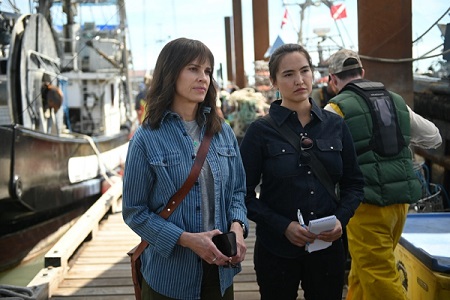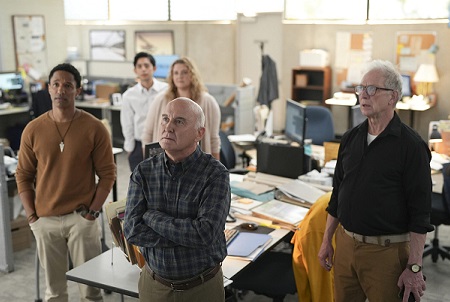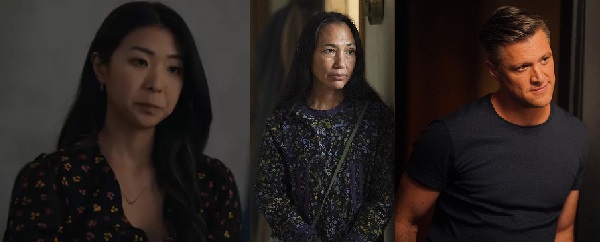Set primarily in Osage County, Oklahoma, the Martin Scorsese movie Killers of the Flower Moon (2023) is based largely on the David Grann book Killers of the Flower Moon: The Osage Murders and the Birth of the FBI. That intrigue around the murders of a Native American tribe relocated to Oklahoma, Missouri and Arkansas with negotiated mineral rights led to government sanctioned theft, racism, and at least tacit sanctioning of murder against Osage Indians generally is where the book and the movie begin to intersect. The Federal Bureau of Investigation under J. Edgar Hoover, as a growing investigative service, provides another intersection point.

With movie writing credits to Eric Roth and Martin Scorsese, the murdering of Osage people for oil rights on a one-by-one basis is the focus. Prior to the realization of this, the introduction of a modicum of Osage cultural tradition with the burial of the a ceremonial pipe, mourning their descendants’ assimilation into white American society. Sharing the yearly “flower moon” phenomenon of Oklahoma fields of bloom, we soon see several Osage dancing among oil gushing from the ground in their territory. Assuming the Osage “incompetent” to manage money in the American sense of it, Osage are assigned allotments of money in full and half-blood members headrights, which cannot be sold and transfer through inheritance to relatives upon death. In addition to graft that is addressed yet is not central to the movie, an incentive for untimely deaths had been created for unscrupulous whites.
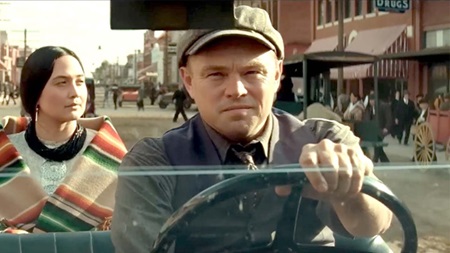
It is with this background that we meet Ernest Burkhart, as portrayed by Leonardo DiCaprio. Having returned from World War One service unintelligent and greedy, Ernest moves in with his brother, Byron Burkhart as portrayed by Scott Shepherd, and his uncle William King Hale as portrayed by Robert De Niro. It’s on the family ranch that we learn of Hale‘s giving gifts to the Osage and speaking their language while serving in a neglectful law enforcement capacity. The depths of Hale‘s conniving against that proposed interest includes suggesting to Ernest Burhart‘s that his nephew strike up a romance with Mollie Kyle, who takes the Burkhart surname when Ernest and Molly marry in a ceremony with Osage and Roman Catholic elements. Lily Gladstone portrayed Mollie Kyle Burkhart, with Mollie’s relationship with Ernest Burkhart becoming a central focus of the movie.

The criminal enterprise elements of the movie grow from here into what we see to be patterns of attack on the wealth and people of the Osage nation in general and Mollie Kyle Burkhart‘s family specifically. The patterns of attack on Lizzie Q, Anna Brown, Minnie Smith and Reta Smith, as portrayed by Tantoo Cardinal, Cara Jade Myers, Jillian Dion and Janae Collins, respectively, being front and center in the murderous plots. It is the escalating plot geared at Bill Smith‘s two wives (Minnie and Reta) and Ernest‘s wife (Molly), in addition to the 1921 Tulsa Race Riot that occurred with an arguably equivalent impunity, led to the Osage tribe’s council seeking reprieve in Washington DC against the corrupt forces in play on the Osage reservation, including a direct appeal to United States president Calvin Coolidge. Jason Isbell portrayed Bill Smith.

Despite of and in the face of these developments, William King Hale escalates his criminality further with the killing of Henry Roan, Mollie‘s first husband as portrayed by William Belleau, the ordering of the murdering of his own hired killers, and unsuccessfully attempting to murder Ernest after he testifies against his uncle. The Bureau of Investigation inquest by agents Thomas Bruce White Sr. and John Wren leads to a trial litigated by Prosecutor Peter Leaward. W.S. Hamilton defends William King Hale and Ernest Burkhart. Jesse Plemons, Tatanka Means, John Lithgow and Brendan Fraser portrayed White Sr., Wren, Leaward and Hamilton, respectively.
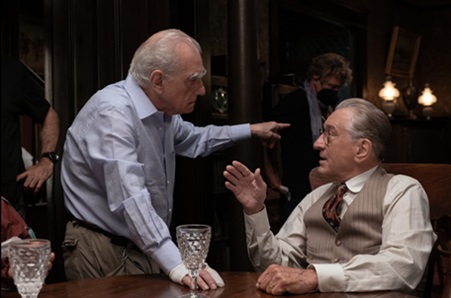
The means of bringing together the larger questions of the fates of William King Hale, Ernest Burkhart, Molly Kyle Burkhart and Anna Brown through a dramatized radio program intermixed with flashback provided an unexpected and dramatically cinematic flare to the movie’s resolution. The movie reels of the Tulsa Race Riots in addition to the opening storytelling tributes to the silent movie era of cinema were appreciated artful touches at earlier parts of the movie. These elevation points raised the bar for me on what quality filmmaking truly can be. It is with these points as backdrops to the story told that I grant Killers of the Flower Moon as directed by Martin Scorsese with a highly accomplished cast 4.25-stars on a scale of 1-to-5.
Matt – Saturday, November 4, 2023


